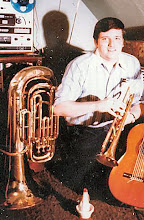

Side One:
1. Way Down Yonder In New Orleans
2. Someday You'll Be Sorry
3. I Found A New Baby
4. Bugle Call Rag
5. Muskrat Ramble
Side Two:
1. Honeysuckle Rose Dinah
2. Milenberg Joys
3. When You're Smiling
4. Memphis Blues
5. Sweet Georgia Brown
Liner Notes:
Conducted by Tony Almerico
Recorded at the Parisian Room, New Orleans, June 10, 1956.
Recording Engineer: Jepson Miller
Produced and directed by Herman Diaz, Jr.
Cover photo by Lucky Kaderian
© by Radio Corporation of America, 1956
Tony Almerico's Dixeland All-Stars
Dixieland Festival, Volume I: A Live Concert From The Rue Royale In New Orleans
Personnel:
Tony Almerico trumpet
Pete Fountain clarinet
Warren Luening, Jr trumpet
"Bugling" Sam Dekemel trumpet
Pee Wee" Spitelera clarinet
Jack Delaney trombone, vocals
Nino Picone tenor saxophone
Frank Federico guitar
Joe Loyacano bass
Johnny Castaing drums
Pinky Vidacovich announcer
New Orleans, of course, was where it all started - where the polkas, the quadrilles, the tangos, the rags and the arias that soared out of the French Opera House were mixed with marches, work songs and hymns and given exotic African rhythms by musicians whose technique was based on nothing but instinct. The resultant fusion, developed by the expressive genius of an amazing succession of natural, unschooled performers, eventually became known as jazz.
It started in New Orleans but long before most people realized that jazz existed, its center had moved up the Mississippi to St. Louis, Kansas City and, principally, to Chicago. That was in the early 1920s and since then it has stretched out horizontally across the country from New York to Los Angeles and San Francisco. It has girdled the globe, reaching into every corner where phonograph records are played. Today, when anyone mentions New Orleans in connection with jazz, it is usually as "the place jazz came from" as though, after it headed up the Mississippi thirty-five years ago, no one had been left at home to carry on the tradition.
But jazz is still played in New Orleans with as much vigor as ever. In reality, jazz never left New Orleans. Instead, New Orleans has spread itself around the world, leaving a small part of itself wherever jazz musicians rally around a downbeat.
This album, featuring Tony Almerico's Dixieland All-Stars, is the first in a series of four Dixieland Festival recordings which will make up a report on the present lively state of jazz in New Orleans.
Tony Almerico's All-Stars, a mixture of seasoned New Orleans men and the town's vigorous younger generation, has been a fixture at the Parisian Room on Royal Street for years. What you hear on this album is exactly what you might hear if you were to walk into the Parisian Room. It is an on-the-spot recording of an actual performance, spontaneous, unrehearsed, taken down exactly as it reached the microphones, complete with the appreciative whistles and clapping of the audience.
Almerico is one of the veterans of the New Orleans musical scene who follows in that tradition started by another old New Orleans man, Louis Armstrong - the trumpet player who also sings. His authoritative lead trumpet is in constant evidence and he turns up vocally on the familiar When You're Smiling.
Joining Almerico in the front line are three of the young stars who are carrying on the vital traditions of New Orleans jazz. Pete Fountain is anexceptional clarinetist with the rich, mellow tone that is the hallmark of the great New Orleans clarinet men. Fountain got his start with The Junior Dixieland Band and the continuing line of New Orleans jazz is emphasized in these performances by the presence of two current members of the Junior Dixielanders - trumpeter Warren Luening, Jr., and clarinetist "Pee Wee" Spitelera. The other horns in Almerico's band are Jack Delaney, a trombonist and singer who is the closest thing to Jack Tea-garden since Teagarden himself, and tenor saxophonist Nino Picone, who plays in the definitive New Orleans tenor style of Eddie Miller.
Balancing this young blood on the horns is a rhythm section that is heavy with experience. Guitarist Frank Federico was in that Ben Pollack band of the mid-Thirties which also featured Harry James, Glenn Miller, Irving Fazola and Freddie Slack. Later he toured with Louis Prima when Prima was leading a small jazz group. Joe Loyacano, on bass, comes from an outstanding New Orleans musical family which contributed three notable jazz performers to the jazz scene in the Twenties - another bassist, Arnold; another Joe, a trombonist; and Steve, a banjo player. Drummer Johnny Castaing was on the road in the same Louis Prima band with Federico and later played with pianist Roy Zimmerman in George Hartman's New Orleans band.
A special added attraction, unique to present-day New Orleans, is "Bugling" Sam Dekemel, a onetime waffle vendor who can play anything in the Almerico band's repertory on his bugle as long as it is in the key of G.
The tunes that the Almerico band plays are familiar standards which have traveled north, east, south and west with New Orleans jazz. Theirs, however, is the native New Orleans interpretation (notice how a New Orleans band tends to end its numbers with a downward slur) and the final stamp of authenticity is put on this presentation by the presence of Pinky Vidacovich, regular announcer for the broadcasts from the Parisian Room, as master of the revels and informant extraordinary.
And now, if you'll follow me into the Parisian Room, we'll drift on down yonder . . . way down yonder.
JOHN S. WILSON




































